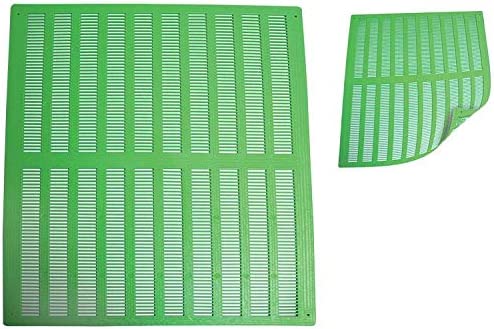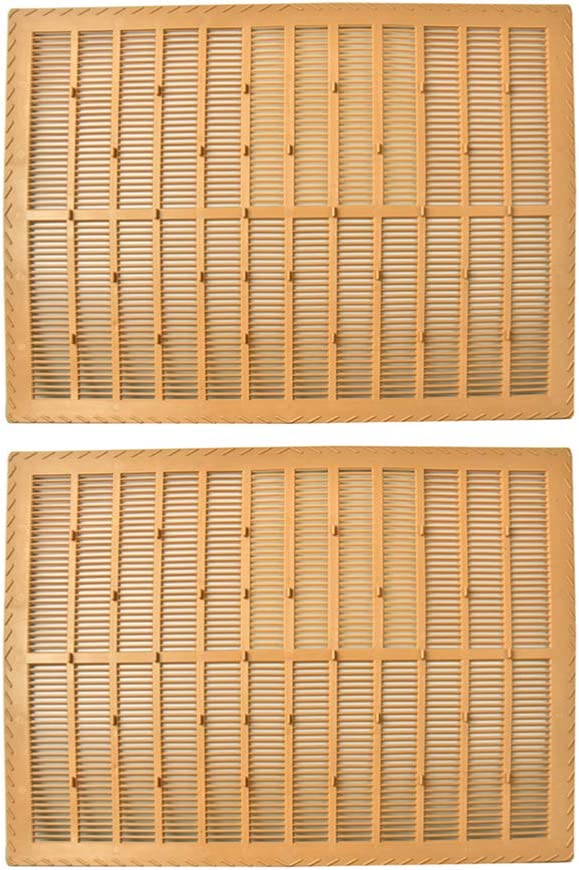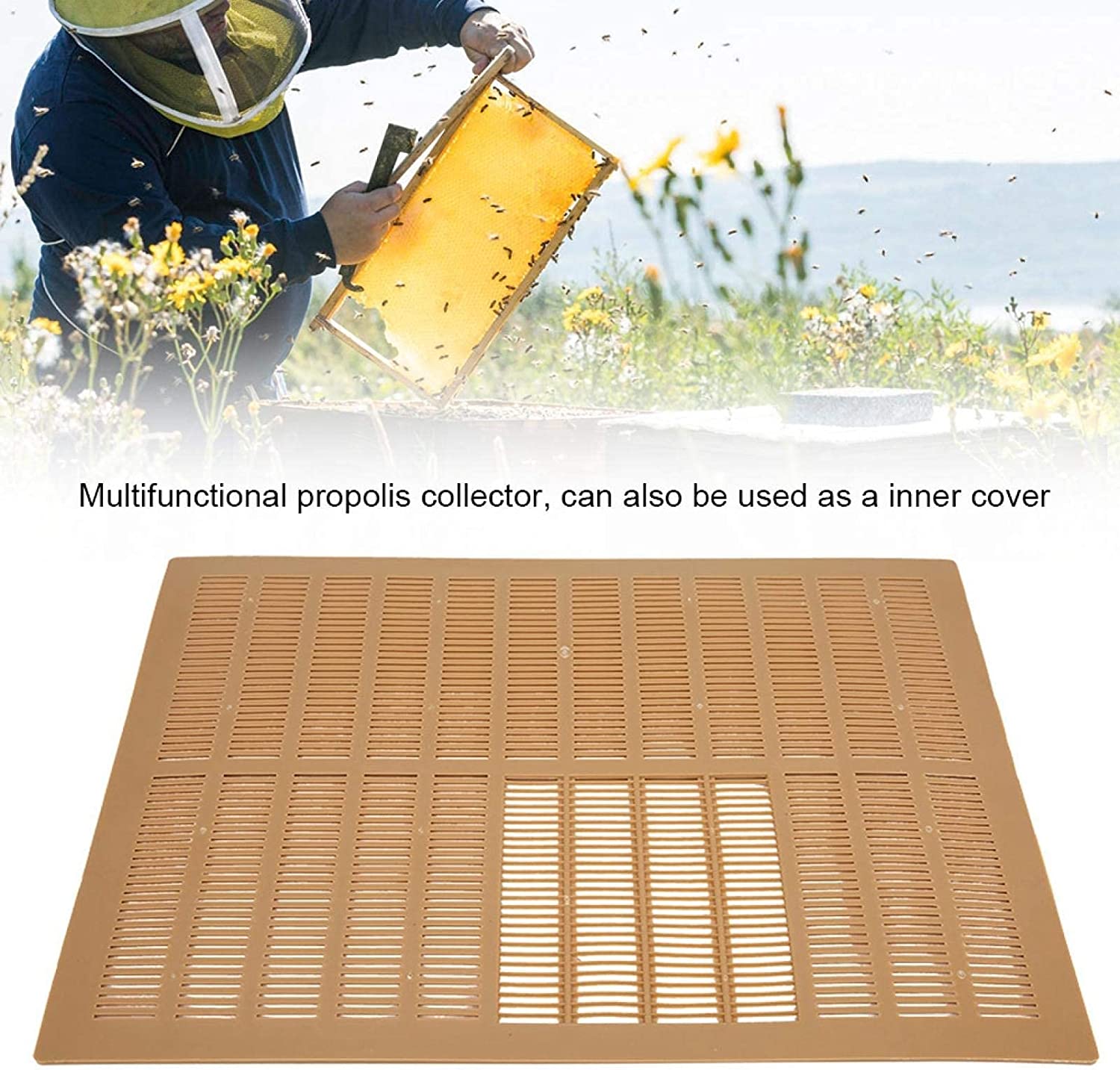If you purchase an independently reviewed item through our site, we earn an affiliate commission. Read our affiliate disclosure.
In this article, we present a comprehensive guide on the best propolis traps. As passionate beekeepers ourselves, we understand the significance of propolis, a resinous substance bees collect from plants. Our article not only reviews the top propolis traps in the market but also offers valuable insights into their usage and benefits. From efficiency in harvesting to maintaining hive health, we cover it all. Whether you’re a novice beekeeper or a seasoned pro, our guide aims to enhance your propolis collection process and contribute to the prosperity of your bee colonies. Join us on this informative journey to optimize your beekeeping practices and make the most out of one of nature’s golden treasures—propolis.
Typical traps feature thin slits that trigger honeybees to seal them with propolis. Materials used to make the traps need to be durable and flexible for easy harvesting of the propolis. Plastic is a great material for making propolis traps. You can also use metallic propolis traps, especially when you have to make one for your beekeeping operation.
What is the Composition of Propolis?
There are many different components that bees use to make propolis. More than 240 compounds have been found, depending on the location of the honeybee colony that made the propolis. Plant resins and saps are a major component in all propolis preparations. The resins and saps of deciduous trees are favored by bees for the making of propolis.
Foraging worker bees collect the resins on their hind legs, and enlist the help of other bees in the beehive to remove the resins from their legs. In the beehive, honeybees combine the sticky resins and saps they collect with waxes and fatty acids. Essential oils too are often present in propolis.
Other components found in propolis samples after analysis include flavonoids, among others in small quantities.
Uses of Propolis in the Beehive
Honeybees make propolis to seal cracks and crevices in the beehive. They also use it to smooth out rough surfaces in the beehive, as well as to reduce the size of beehive entrances to sizes that the honeybee colony can guard effectively. Some people refer to it as ‘bee glue’. Propolis is red or brownish. Warm propolis is sticky, whereas cold propolis is hard and brittle. You will usually encounter hard and brittle propolis in beehives. It may flake off surfaces in chunks of various sizes, or in nearly powder form.
In addition to sealing and closing off spaces in the beehive, propolis contributes to the overall health of honeybees. This is through its antimicrobial properties. Honeybees have little natural immunity in comparison to other insects and animals. By killing microbes and preventing their growth too, propolis helps keep honeybees safe from those that would harm them.
Propolis Production and Collection
Factors that trigger the production and use of propolis in a beehive include disease infections, drafts of light and wind entering the beehive, rough surfaces present in the hive, cracks and crevices smaller than 5/16th of an inch, and too wide beehive entrances.
Commercial propolis traps are made using thin plastic sheets that have narrow slits in them. The beekeeper places the trap between the uppermost honey super box and the top cover of the beehive. It replaces the inner cover of the beehive. Leaving the outer cover of the beehive slightly ajar to allow light and air into the beehive triggers the bees in the beehive to seal the propolis trap with propolis. It gives you a crop of propolis faster than when you leave the outer cover flat over the top of the beehive.
How to Use Propolis Traps
Remove the plugged propolis trap from the beehive and replace it with a fresh one if you want to. Handle it carefully to avoid breaking off the propolis from the trap. Immediately placing the trap in a clean food-safe sealable bag or container helps you catch any propolis that flakes off of the trap during subsequent handling and transportation. Freeze the propolis trap in its bag for a few hours.
When the propolis is well frozen, get the trap from the freezer and lightly tap it against a clean and smooth surface that will not damage it. Increase the force you apply in tapping the propolis trap against a hard surface until all or most of the propolis comes off the trap. You may also contort the trap back and forth to cause the cold and brittle propolis to break up and detach from the trap. The propolis coming off the trap is caught in the clean bag into which you had placed your propolis trap.
Overview of the Best Propolis Traps
1. Blythewood Bee Company Propolis Trap 10 Frame
This is a plastic propolis trap for use with 10-frame Langstroth beehives. The Blythewood Bee Company propolis trap 10-frame is made by a reputable company in the production of supplies for beekeeping. It is well constructed from a single sheet of plastic. This leaves the propolis trap with very few or no weak points in its body. It is, therefore, flexible, and durable and will give you a lot of value and years of service if you handle it properly when using it. Making the trap using plastic allows for the safe freeing of the pollen trap and no damage to the trap in the process of harvesting the collected propolis.
This propolis trap features many thin grooves in sections over the entire body of the trap. Honeybees seal the grooves with propolis which you later harvest by freezing and then later breaking the propolis off the trap. This pollen trap is for use at the top of your beehive stack as a replacement for your regular inner cover. It measures 20 x 16 ¼ x 1/10 inches, which is equivalent to 50.80 x 41.28 x 254 centimeters.
Check Price
3. Aeloa Plastic Beehive Propolis Trap
The Aeloa Plastic Beehive Propolis Trap is a light trap that is commercially made and sold. It is fashioned out of plastic and weighs 9.6 ounces only. This trap is sturdy and durable because it is made using high-quality plastic that is food-safe too. The trap replaces your Langstroth beehive’s inner cover when you are using it to collect propolis in the beehive. Its design makes it effective and efficient at collecting propolis. The trap measures approximately 19.88 x 16.14 inches (50.5 x 41 centimeters). It is suitable for use in 10-frame beehives. You may reduce its size to fit 8-frame Langstroth beehives using strong scissors or a razor cutter.
Though plastic, bees will generally accept the trap and work comfortably with it. The trap does not harm honeybees. It is useful beekeeping equipment to collect propolis in your beekeeping operation. Both beginner and experienced beekeepers can easily use the Aeloa Plastic Beehive Propolis Trap to collect and harvest propolis.
Check Price
3. Happyyami Plastic Beehive Propolis Trap
The Happyyami Plastic Beehive Propolis Trap is multifunctional since it doubles as a beehive inner cover. It is made using high-quality plastic material. Construction of the trap also shows attention to proper design for best functioning. Additionally, the propolis trap is sturdy and durable. No parts of the propolis trap are affected by rotting which may happen with propolis traps that have wooden components or parts in them. This propolis trap has rounded edges that ensure that honeybees that come into contact with it do not hurt any part of their bodies.
This propolis trap features some ventilation channels built into its plastic body. Channels for ventilation allow for the exchange of air between the environment outside the beehive and the cavity enclosed by the beehive. Honeybees initiate air exchange between the two environments to prevent moisture from building up in the beehive. Ventilation channels in the Happyyami Plastic Beehive Propolis Trap, therefore, enable humidity control in the beehive where you are using it. It also facilitates fast and effective cooling of the beehive by bees in hot weather.
Check Price
4. Kathlen Plastic Beehive Propolis Trap
The Kathlen Plastic Beehive Propolis Trap is a durable and sturdy propolis trap made using plastic material. The trap is safe for use with honeybees and food for human consumption. It is designed to be eco-friendly and non-toxic while being safe beekeeping equipment to use in the beehive. The pollen trap measures approximately 19.88 x 16.14 inches (50.5 x 41 centimeters).
This plastic propolis trap is effective in its job and gives you a lot of propolis per harvest. Use it in replacement of your Langstroth beehive’s inner cover over the uppermost honey super box of the beehive stack. The propolis that you collect using this trap is clean. It saves you the work of cleaning propolis after collection. The Kathlen Plastic Beehive Propolis Trap also ensures a hygienic propolis collection while making the process easy for both you and the honeybees.
Check Price
Homemade Propolis Traps
Homemade propolis traps work with the same effectiveness and efficiency as commercial traps. You can fashion one using wood for the frame of the propolis trap and some material in the middle. The material you use in the middle of the trap should have small openings or slits that honeybees will want to seal with propolis. It should also be food-safe, durable, and easy to work with. You can generally use a piece of nylon window screen or metal screen wire inside the wooden frame to make a trap. Ensure that you construct the homemade propolis trap using good quality materials so that it lasts for a long time.
How to Clean Propolis
Propolis that you collect or harvest from other surfaces by scraping it from the surfaces of beehives, hive components, tools, and equipment, often has contaminants in it. Separating the contaminants from the propolis takes time and requires special materials and processes. Common contaminants in such propolis are wax, dead bees, and bits of wood.
1. Using Water
You can remove them from the propolis by soaking the propolis in water. The propolis sinks to the bottom of the water container, while contaminants tend to remain afloat on the surface of the water.
2. Using Heat and Water
You may also heat the propolis in water to about 200°F (93.3°C) in a safe and suitable container with frequent stirring. The propolis sinks to the bottom of the container, warms up, releases particulate contaminants, and sticks to the bottom of the container. Contaminants released from the propolis usually float up to the surface of water. Stir the mix of propolis and water during heating to preserve the components of the propolis as much as you can.
Use indirect heating on the container of propolis and water. After about an hour of heating, allow the water to get still and remove the floating items from the water’s surface. Upon cooling, propolis stuck to the bottom of the container stays in the container and you can pour off the water.
Further cooling and freezing allow for easy breaking of the propolis to get it from the container you used and into suitable storage containers.
Processing, Packaging, and Presentation of Propolis
Clean propolis does not need processing. You can use propolis by placing it in your mouth and sucking on it. Put the propolis chunk between your gum and cheek. If the propolis comes into contact with your teeth, it may stick to them. This method works for the use of propolis to address sore throat and dental and gum issues. Other preparations and presentations of propolis for human uses are in tablet form, powdered capsules, extracts or tinctures, enriched oil extract, and aqueous or hydrolyzed propolis. You can safely make some of the presentations of propolis in your home, but making others carries too much risk of harm.
Conclusion
In conclusion, the exploration of the best propolis traps, both commercial and homemade, has provided valuable insights into the diverse options available for beekeepers. As someone who has ventured into the world of beekeeping, the journey to find the most effective propolis traps has been both enlightening and rewarding.
The commercial traps, with their sleek designs and purpose-built features, offer convenience and efficiency. The ease of installation and the minimal intrusion into the hive make them attractive choices for beekeepers seeking hassle-free solutions. I found the Kathlen Plastic Beehive Propolis Trap to be particularly effective in collecting propolis without disrupting the hive dynamics. Its design not only facilitated propolis harvesting but also ensured the well-being of the bee colony.
On the other hand, the homemade traps demonstrated the ingenuity of beekeepers who have crafted solutions tailored to their specific needs. Experimenting with various materials and designs, I discovered that propolis traps made using metal screen wire proved to be a surprisingly effective and cost-efficient alternative. The satisfaction of crafting a propolis trap from simple materials and witnessing its success in action added an extra layer of fulfillment to the beekeeping experience.
Regardless of whether one opts for commercial or homemade propolis traps, the key takeaway is the significance of integrating these devices into the beekeeping routine. Propolis, with its various medicinal properties, is a valuable resource that should not go to waste. The traps not only aid in the collection of this precious substance but also contribute to maintaining a healthier and more hygienic hive environment.
In the end, the choice between commercial and homemade propolis traps boils down to personal preferences, resources, and the specific needs of the beekeeping operation. As I reflect on this journey, I can confidently attest that the exploration of propolis traps has enhanced my understanding of bee behavior, strengthened my connection to the hive, and enriched the overall beekeeping experience.
What are your thoughts on this article? Leave a comment below and let us know.
 BeeKeepClub Resources and Guides for Beekeepers
BeeKeepClub Resources and Guides for Beekeepers




[…] are so many brands out there that design propolis traps. If you are interested in harvesting propolis, then a propolis trap can make your work so much […]